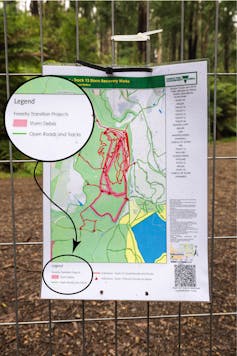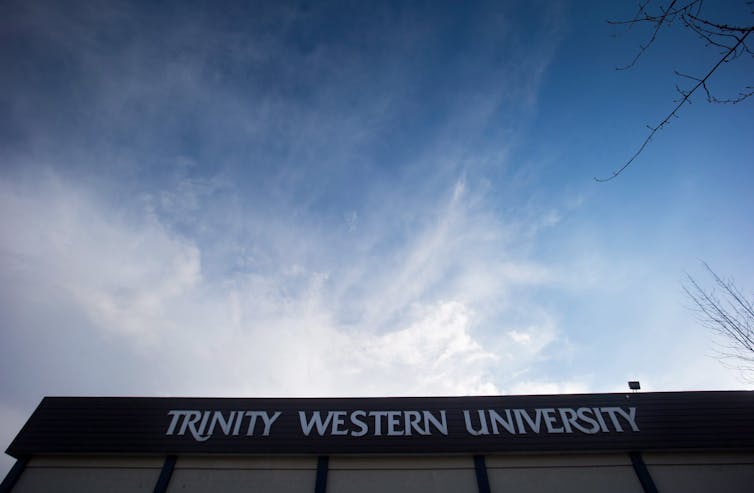Victoria’s native forest logging industry ended on January 1 this year. The news was met with jubilation from conservationists.
But did logging really end? Last week, an endangered southern greater glider was found dead next to an area logged to create fuel breaks along the Yarra Ranges National Park. The news triggered outrage.
By itself, the death of one glider would be sad. But its death speaks to a larger problem. Three kinds of logging are continuing in Victoria’s forests, for fuel breaks, salvage logging after windstorms, and logging on private land. The first two are linked to the government’s Forestry Transition Program, which states:
Harvest and haulage workers will be offered alternative work in forest and land management, enabling them to continue to work in the forests they know so well and contribute to bushfire risk reduction.
These types of logging are likely to continue for years to come – and with less oversight than under the old regime, when logging was done by the state government agency VicForests.
Fuel breaks
The Victorian government has plans to cut or expand almost 1,500 kilometres of fuel breaks throughout Victoria’s native forests and other types of vegetation. Some of these fuel breaks are being cut in the tall mountain ash forests of Victoria’s Central Highlands, northeast of Melbourne. The trees cut down are being carted to timber mills.
It has been claimed the fuel breaks are intended for use by fire-management workers to do backburning and reduce fuel if there’s a serious bushfire in a region.
This may work in some drier grassland and woodland environments. But it doesn’t make sense in tall, wet mountain ash forests, which burn only in the most severe of fire weather conditions. These conditions are the worst possible time to light other fires.
So if this logging doesn’t make sense as fuel breaks, what is it for? Government maps of the fuel breaks label them as “Forestry Transition Projects”.
Chris Taylor, Author provided (no reuse)
When trees are felled, harvest and haulage contractors are paid to cart the logs away. The contracts are for five years.
Fuel break logging is indiscriminate. A number of the trees already logged are between 200 and 350 years old, based on their diameters. These old trees are keystone structures and it is easy to identify them as trees which should never be cut down.
Nationally endangered southern greater gliders rely on tree hollows, which develop only in older trees – those with a diameter of 1.2 metres or larger. We have recently shown the loss of these trees is a major reason why this iconic species has declined catastrophically.

Wildlife of the Central Highlands, Author provided (no reuse)
Salvage logging
Salvage logging is where logs are removed after windstorms or fires damage trees. This is taking place in the Wombat State Forest, Mount Cole State Forest, and even in national parks like the Dandenong Ranges National Park. The timber from salvage logged forests usually goes to sawmills and firewood yards.
Many people might think salvage logging makes sense. In the wake of unprecedented windstorms knocking down thousands of trees, doesn’t it make sense to cart the logs away and put them to use?
On a forest scale, salvage logging is the most destructive form of logging, worse than high-intensity clearfelling. Logging soon after a natural disturbance makes recovery harder, such as by badly damaging soils for many decades.
Fire-damaged or fallen trees become significant habitat for many plants and animals. Forests may take as long as 200 years to recover after salvage logging. Importantly, salvage logging operations can also make forests more flammable.
After widespread storms hit the Wombat Forest in 2021, the Dja Dja Wurrung Clans Aboriginal Corporation (DJAARA) appointed VicForests to undertake “making Country safe”, in part by salvage logging windthrown timber, but large numbers of living trees were also cut.

Chris Taylor, Author provided (no reuse)
Since VicForests wound up its operations in January, DJAARA has stated continued logging in the Wombat Forest by the Victorian government is no longer part of its operations.
Logging on private land
Gliders and other forest creatures don’t know the difference between national park and private property.
Using Sentinel 2 satellite imagery, we have been monitoring a large clearfell logging operation on private land next to the southern boundary of the Yarra Ranges National Park. The logging began in March 2023 and is ongoing. 38 hectares of mountain ash forest, a critically endangered ecosystem, have been clearfelled.
Laws governing logging on private land can be weaker than logging in public state forests. In state forests, VicForests were bound to follow detailed regulations, but these do not apply to logging on private land.
Satellite images suggest this logging operation is being done very close (less than 50m) to locations known to support the critically endangered Leadbeater’s Possum, a tiny possum whose population in the wild may be as low as 2,500 individuals. These locations have been formally recorded and documented by the Victorian Government.
When VicForests was in operation, foresters and logging contractors were legally bound to provide a 200-metre buffer around sites known to be used by these possums. Logging on private land has no such requirement.

Sentinel 2 satellite imagery, 01/05/2024, Author provided (no reuse)
Logging hasn’t truly stopped
Whether for fuel breaks, salvage logging, or private land logging, native forest logging hasn’t stopped in Victoria. It will continue for many years, and the logs cut from these operations will be sold commercially.
Much of this logging is not be fully regulated, as the Office of the Conservation Regulator is in the same department as the one conducting fuel break and salvage logging. It is difficult for a government department to regulate itself. This regulator also has no power over logging on private land.
If it sounds like two steps forward, one step back, it is.




